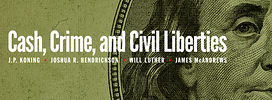Before I begin my response I’d like to thank James McAndrews, Josh Hendrickson, and Will Luther for participating in this conversation, I very much enjoyed reading their responses.
While Luther and McAndrews provided qualified support for the idea of adding a new high denomination U.S. note, all three commentators push backed against the idea of having it depreciate so that an extra tax is placed on supernote owners.
There are several technical and fundamental criticisms. On the technical side, McAndrews questions whether the monetary authority’s stipulated redemption rate will pass through to end users of currency, especially given the fact that banknotes are traded in decentralized markets.
Central banks often cancel, or demonetize, various denominations of banknotes. Sweden recently demonetized the 1,000 kronor banknotes because they lacked strong anti-counterfeiting measures, replacing them with a new issue. A more notorious example is India’s sudden demonetization of its 1,000 and 500 rupee notes. I’d argue that each reduction in the redemption rate for supernotes is similar to a demonetization, the difference being in scope: in the latter case the central bank annuls the entire value of a note whereas in the former it annuls just part of it. We know that demonetizations are generally passed through to decentralized banknote markets. Neither the old Swedish 1,000 kronor nor either of the two Indian demonetized notes continues to circulate. If the market listens to demonetizations, it seems like it would do the same with a tax.
Turning to non-technical criticisms, Luther and McAndrews both point out that a supernote tax would penalize not only those engaged in noxious activity but also those who use the note for good purposes.
I think this characterization is right, but it seems no different to me than other markets on which society has deemed it appropriate to levy a corrective tax. Take the alcohol market. Heavy alcohol users can impose a number of costs on society including family problems, assaults, intoxicated driving, and vandalized property. At the same time, there are many responsible drinkers who benefit from the occasional glass of wine. While the existence of good uses for alcohol complicates the social welfare calculation, it doesn’t mean that the alcohol market should not be taxed. The economic distortions imposed on responsible drinkers by the tax are presumably outweighed by the benefit of having heavy drinkers bear the costs of the damages they impose on others. A tax on supernotes would work along the same principles.
Hendrickson questions whether the sorts of activities enabled by supernotes qualify as externality-generating. Pollution is a text-book externality, says Hendrickson, since it causes genuine health and productivity problems. The illegal activity facilitated by banknotes might annoy others, he points out, but this distaste isn’t the sort of externality that society generally tries to correct for.
This is probably true of many illegal activities enabled by cash, such as prostitution. Observers might find the activity abhorrent, but they do not suffer physical harm from it. However, it seems to me that tax evasion abetted by banknotes is more than just distasteful; it hurts other tax payers. To keep up the same level of government spending, the “suckers” must make up for the cheats by paying more than their fair share.
Luther minimizes the costs of tax evasion, referring to an article in which he describes tax cheating as a “mere” transfer. According to Luther, the government is made worse off, but tax cheats are better off, so in a social welfare calculation the two effects offset each other.
I’m not convinced that the arithmetic used to account for tax cheating can be reduced to a simple transfer. Let me turn to an analogy. Imagine that some sort of broadly available financial technology allowed people to easily steal from Wal-Mart and other retailers. We might describe the jump in theft that Wal-Mart suffers as a mere transfer, the thieves benefitting to the degree that Wal-Mart shareholders lose. But we would also worry about the damage that this theft-enabling technology does to the institution of property rights. If there is a general reduction in society’s sense of quid pro quo—the idea that a solid day’s work leads to a solid day’s pay—then an economy can’t function as well as it should.
In the same way that the theft-enabling technology hurts the institution of property rights, cash-based tax evasion damages the delicate balance that keeps a well-designed tax system functioning. Without a sense of quid pro quo, would-be taxpayers may simply choose to become cheaters.
Luther also mentions that the rate of return on cash should be boosted so that it yields the same rate as a risk-free bond, as suggested by Milton Friedman. I am sympathetic to this idea but would prefer to limit the application of the Friedman rule to low denomination notes, as they are more likely to be used for licit transactional purposes. So for example, $1s, $5s, and $10s would all bear interest while supernotes would continue to have a negative rate of interest applied to them.
Finally, Luther’s calculation for the amount of illegally used U.S. banknotes points to the inadequacy of data being used to guide this discussion. While it is certainly difficult to collect information about underground usage of banknotes, one hopes that central banks will make more efforts in this direction given the growing importance of questions about financial privacy.

